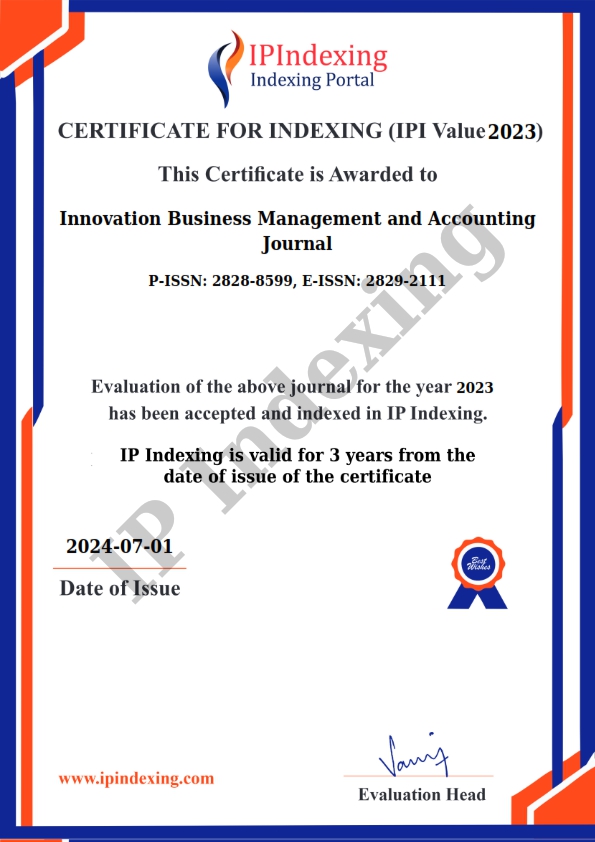Enhancing Student Financial Literacy through Collaborative Value Creation in West Java
DOI:
https://doi.org/10.56070/ibmaj.2024.029Keywords:
Collaborative Process, CVC Framework, Financial Literacy, Value CreationAbstract
Financial literacy education is essential for students as it provides a strong foundation for managing their finances in the future. This study aims to evaluate the effectiveness of creating a value process in increasing students' financial literacy and determine what components need to be optimized in OJK of West Java Province's collaboration program and their partners based on the Collaborative Value Creation (CVC) Framework. The research method used is descriptive qualitative with data collection techniques through semi-structured interviews and documentation. The collaboration by OJK of West Java Province has been effective but can be optimized to achieve transformational collaboration, which has the most significant impact on partners and the wider community. Among the five components that need to be improved are collaborative value-creation processes and the need to measure the impact of collaborative programs or activities on participants who receive financial education.
Downloads
References
Abrari, A. M. (2023). The Influence of Financial Literacy and Financial Inclusion on MSME Financial Performance in Makassar City. Economics and Business Journal (ECBIS), 1(2), 87–92. https://doi.org/10.47353/ecbis.v1i2.15
Afandi, M. N., Tri Anomsari, E., Novira, A., & Sudartini, S. (2023). Collaborative governance in a mandated setting: shifting collaboration in stunting interventions at local level. Development Studies Research, 10(1). https://doi.org/10.1080/21665095.2023.2212868
Austin, J. E., & Seitanidi, M. M. (2014). Creating Value in Non Profit - Business Collaborations: New Thinking and Practice. Jossey-Bass Inc., Publishers.
Austin, J. E., & Seitanidi, M. M. (2016). Value creation through collaboration. The Jossey-Bass Handbook of Nonprofit Leadership and Management, 427–443. https://doi.org/10.1002/9781119176558.ch15
Baeckström, Y., Marsh, I. W., & Silvester, J. (2021). Financial advice and gender: Wealthy individual investors in the UK. Journal of Corporate Finance, 71. https://doi.org/10.1016/j.jcorpfin.2021.101882
Bao, D. Q., Phong, N. D., & Tho, N. D. (2023). Co-creation in higher education and quality of college life: The roles of students’ co-creation effort, interactions, and mindfulness. International Journal of Management Education, 21(3), 100862. https://doi.org/10.1016/j.ijme.2023.100862
Istan, M. (2023). The Role of Government, Financial Literacy and Inclusion on MSME Finacial Performance. Owner, 7(2), 1514–1525. https://doi.org/10.33395/owner.v7i2.1383
Khan, F., Siddiqui, M. A., & Imtiaz, S. (2022). Role of financial literacy in achieving financial inclusion: A review, synthesis and research agenda. Cogent Business and Management, 9(1). https://doi.org/10.1080/23311975.2022.2034236
Kiaei, M., Mohammadi, F., Hosseinkhani, Z., & Motalebi, S. A. (2022). Assessing Mediating Role of Financial Satisfaction in the Relationship of Financial Literacy With Quality of Life in Retired Older Adults. Iranian Journal of Ageing, 17(3), 322–337. https://doi.org/10.32598/sija.2022.2778.5
Miles, M. B., Huberman, A. M., & Saldana, J. (2014). Qualitative Data Analysis: A Methods Sourcebook (3rd ed.). SAGE Publications Inc.
Muhamad, N. (2023). Kelompok Pelajar dan Pekerja Muda Punya Utang Pinjol Terbanyak pada Juli 2023. Databoks. https://databoks.katadata.co.id/datapublish/2023/09/05/kelompok-pelajar-dan-pekerja-muda-punya-utang-pinjol-terbanyak-pada-juli-2023
OECD. (2023). OECD/INFE 2023 international survey of adult financial literacy. https://www.oecd-ilibrary.org/docserver/56003a32-en.pdf?expires=1718405913&id=id&accname=guest&checksum=F6E21C1D93B084595E885AAEC52BA3A3
OJK. (2022). Infografis Hasil Survei Nasional Literasi dan Inklusi Keuangan Tahun 2022. OJK. https://ojk.go.id/id/berita-dan-kegiatan/info-terkini/Pages/Infografis-Survei-Nasional-Literasi-dan-Inklusi-Keuangan-Tahun-2022.aspx
Mursalim, W., Ravenska, N., & Wijayanti, R. (2020). Penguatan pengusaha pemula berbasis teknologi jawa barat melalui pendampingan inkubator bisnis politeknik STIA LAN Bandung. SeTIA Mengabdi : Jurnal Pengabdian Kepada Masyarakat, 1(1), 1–9.
Pham, T.-A. N., Le, H. N., Nguyen, D. T., & Pham, T. N. (2022). Customer service co-creation literacy for better service value: evidence from the health-care sector. Journal of Services Marketing, 36(7), 940–951. https://doi.org/10.1108/JSM-09-2021-0323
Respati, D. K., Widyastuti, U., Nuryati, T., Musyaffi, A. M., Handayani, B. D., & Ali, N. R. (2023). How do students’ digital financial literacy and financial confidence influence their financial behavior and financial well-being? Nurture, 17(2), 40–50. https://doi.org/10.55951/nurture.v17i2.154
Sabri, M. F., Said, M. A., Magli, A. S., Pin, T. M., Rizal, H., Thangiah, N., Ithnin, M., Abdul Majid, H., Ismail, R., Su, T. T., & Husniyah, A. R. (2022). Exploring the Relationships of Financial Literacy and Financial Behaviour with Health-Related Quality of Life (HRQOL) among the Low-Income Working Population in Malaysia during the COVID-19 Pandemic. International Journal of Environmental Research and Public Health, 19(19), 1–15. https://doi.org/10.3390/ijerph191912520
Wijayanti, R., Ravenska, N., & Nugroho, A. (2022). Business Model Innovation with Design Thinking Approach at Bumdes Pagerwangi. Proceedings of the Third International Conference Administration Science, ICAS 2021. https://doi.org/10.4108/eai.15-9-2021.2315259
Yeh, T. ming, & Ling, Y. (2022). Confidence in Financial Literacy, Stock Market Participation, and Retirement Planning. Journal of Family and Economic Issues, 43(1), 169–186. https://doi.org/10.1007/s10834-021-09769-1
Downloads
Published
How to Cite
Issue
Section
License
Copyright (c) 2024 Nanda Ravenska, Sulaeman Rahman Nidar

This work is licensed under a Creative Commons Attribution-ShareAlike 4.0 International License.



